

How to Install Rough Country 3.25" Lift Kit on your 2007-2013 Wrangler
Tools Required
- 9/16" Socket
- 3/4" Socket
- 16mm Wrench
- 16mm Socket
- 18mm Wrench
- 18mm Socket
- 19mm Deep Well Socket
- 21mm Socket
- 22mm Socket
- Jack
- Jack Stands
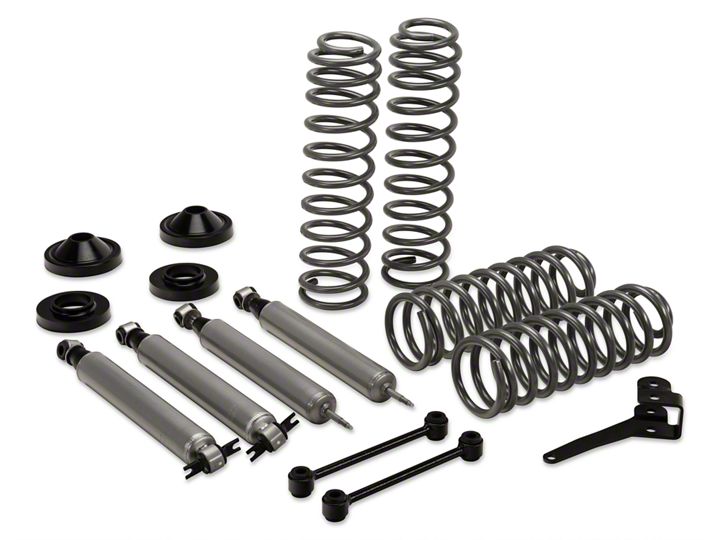
Shop Parts in this Guide
Thank you for choosing Rough Country for all your suspension needs.
Rough Country recommends a certified technician install this system. In addition to these instructions, professional knowledge of disassemble/reassembly procedures as well as post installation checks must be known. Attempts to install this system without this knowledge and expertise may jeopardize the integrity and/or operating safety of the vehicle.
Please read instructions before beginning installation. Check the kit hardware against the kit content list on this page and the kit layout on the back page. Be sure you have all needed parts and know where they go. Also please review tools needed list and make sure you have the necessary tools to install this kit.
PRODUCT USE INFORMATION
As a general rule, the taller a vehicle is, the easier it will roll. Seat belts and shoulder harnesses should be worn at all times. Avoid situations where a side rollover may occur.
Generally, braking performance and capability are decreased when larger/heavier tires and wheels are used. Take this into consideration while driving. Do not add, alter, or fabricate any factory or after-market parts to increase vehicle height over the intended height of the Rough Country product purchased. Mixing component brands is not recommended.
Rough Country makes no claims regarding lifting devices and excludes any and all implied claims. We will not be responsible for any product that is altered.
This suspension system was developed using a 35” X 12.5” X 17” tire with factory wheels. If bigger/wider tire are used with the factory wheels or factory offset wheels you must carefully check the clearance during turning between the tires and the lower control arm and the front sway bar link before driving. If you have any questions concerning the design, function, and correct use of our products contact us at 800-222-7023.
IMPORTANT NOTE : The draglink must be adjusted to center the steering wheel BEFORE the vehicle is driven. Failure to do so will cause a computer error in the Jeep’s traction control system.
On Automatic equipped vehicles; due to use of an oversize driveshaft from the factory and inadequate factory clearance it may be possible for the front driveshaft to come in contact with the automatic transmission pan tearing the factory boot and rubbing on the shaft. Generally this occurs during heavy articulation when front sway bar links are disconnected and longer shocks are installed. If this is found to occur, the proper procedure would be to replace the oversize factory shaft with an aftermarket smaller diameter shaft to increase clearance between the transmission and front driveshaft. Rough Country does offer this driveshaft if needed.
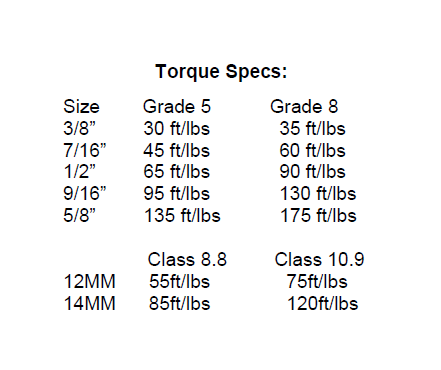
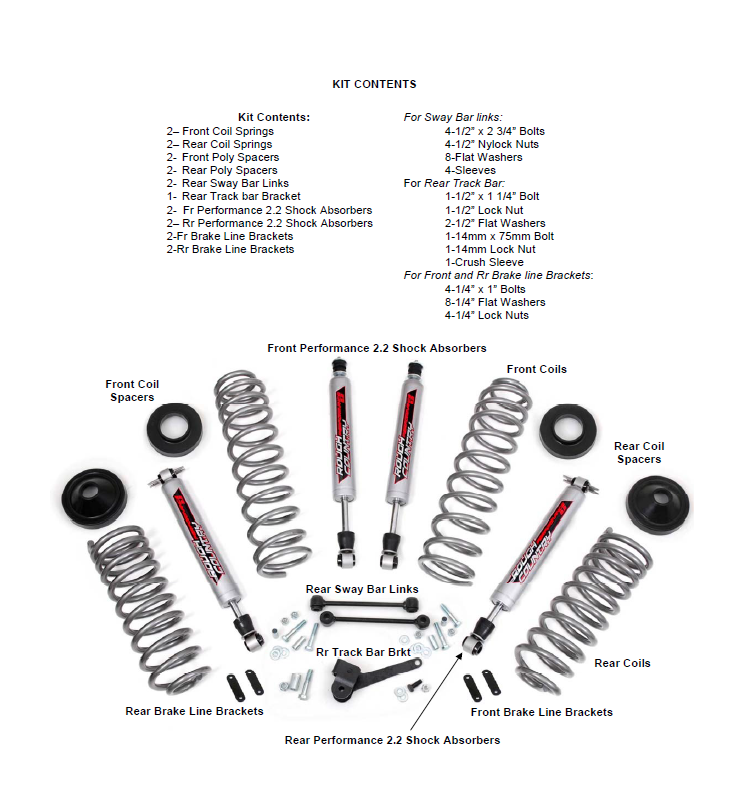
FRONT INSTALLATION INSTRUCTIONS
1. Chock the rear wheels and jack up the front of the vehicle and support the vehicle with jack stands so that the front wheels are off the ground.
2. Using a 19mm deep well socket remove the front tires/wheels,
3. Using a 18mm socket and wrench remove the bottom bolt and the upper sway bar nuts. Retain the lower hardware for later use. See Photo 1
4. Using a 18mm socket and wrench remove the lower shock bolt. See Photo 2. Retain the lower hardware for reuse.

5. Using a 10MM socket, remove the brake line bracket from the stock location.
6. Locate the brake line bracket and install using the stock hardware. Install the stock brake line on the other end of the bracket using the supplied 1/4” X 1” bolts. See PHOTO 3. Use caution when moving the brake line to not kink the metal line.
7. Push down on the axle to allow room for the coils to be removed. Remove coil springs. 8. Install the new coil spring (Longer Coil) with the supplied 3/4” spacer as shown in Photo 4 making sure the stock isolator is in place above the new spacer.
9. Install the Rough Country Performance 2.2 shocks in the factory location with the factory bolt in the lower shock mount. Tighten the lower using a 18mm socket and wrench and the upper using a 9/16” wrench. See Photo 5.
10. Reinstall the front tires/wheels and tighten to factory specifications.
11. Remove the jack stands and lower the vehicle to the ground.
12. On the rear of the vehicle remove the factory sway bar link using a 18mm socket and wrench on the lower. Remove the upper hardware using a 18mm wrench and a 19mm wrench on the ball joint end. This link will be relocated to the front.
13. Install the factory rear sway bar link in place of the factory front sway bar link. Attach the swivel end of the link to the factory sway bar using the stock hardware. Line up the eye end of the link to the factory mount on the axle, attach using the factory hardware. Tighten the upper using a 18mm and 19mm wrench, and lower using a 18mm socket and wrench.
14. The draglink must be adjusted to center the steering wheel BEFORE the vehicle is driven. Failure to do so will cause a computer error with the Jeep’s traction control system and will result in odd handling and poor performance.
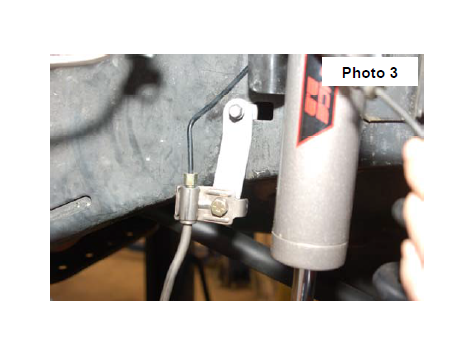
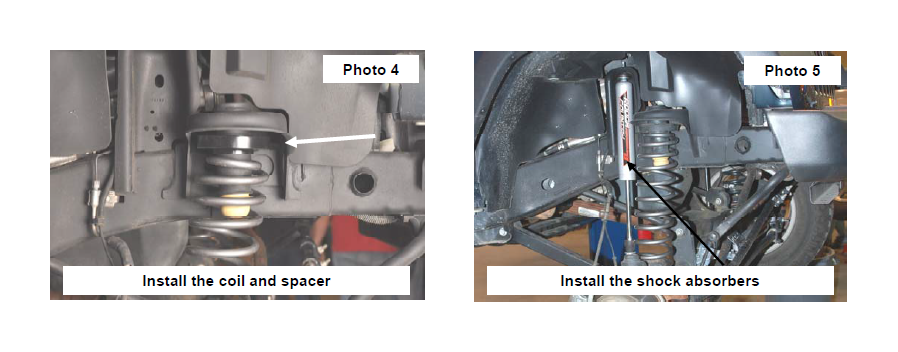
REAR INSTALLATION INSTRUCTIONS
1. Chock front wheels and jack up the rear of the vehicle and support the vehicle with jack stands so that the rear wheels are off the ground.
2. Remove the rear tires/wheels using a 19mm deep well socket.
3. Remove the upper shock bolt using a 16mm socket and wrench. Remove the lower shock bolt using a 18mm socket and wrench and remove the factory shock. See Photo 6. Retain the lower shock hardware for reuse.
5. Using a 10mm wrench, unbolt the brake hose bracket at the frame. Retain hardware for later use.
6. Remove the track rod from the passenger side frame mount using a 21mm wrench. Retain the hardware for reuse. It may be necessary to raise or lower to take the pressure off of the track rod bolt.
7. Push down on the axle to allow enough room for stock coil spring to be removed. Remove the stock coil spring.
8. Install the supplied 3/4” spring spacer on the top of the new coil spring (Shorter Coil) and install the new Rough Country coil spring in the factory coil mount with the stock isolator installed above the new spacer. See Photo 7.
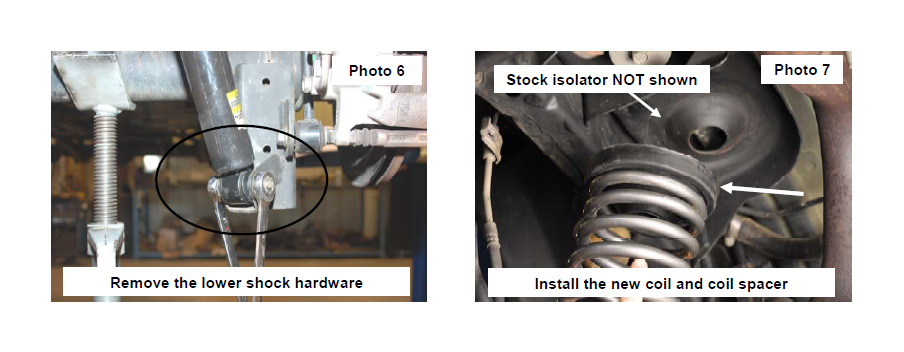
9. Locate the 4 sway bar link sleeves. Insert the sleeves into the sway bar link bushings.
10. Using the supplied .500-16 x 2.75” bolts, washers and nuts from 1681bag, install the sway bar links to the sway bar, and axle mount., and tighten using a 13/16” socket and 7/8” wrench. See Photo 8 . Make sure the bolts are installed with the head of the bolt toward the tire as shown.
11. Install new bracket and spacer sleeve as shown in Photo 9 in the stock location. Secure with the supplied 14mm x 75mm hardware in the upper hole.
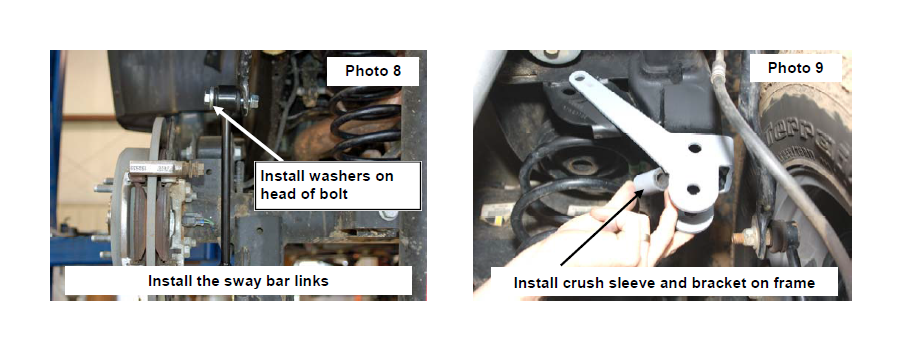
12. Secure the bracket as shown in Photo 10 with the supplied 1/2” x 1 1/4” hardware. Tighten using a 3/4” wrench & socket.
13. Attach the brake line bracket to the location on the frame where the factory bracket was attached. Tighten using a 10mm wrench and stock hardware. Secure the factory bracket to the bottom hole of the relocation bracket using a 7/16 wrench and the supplied .250-20 x 1” bolts, washers, and nuts. See PHOTO 11.
14. Install the rear Rough Country Performance 2.2 shock in the factory location using the factory hardware. Tighten the upper mount using a 16mm wrench and a 18mm wrench for the lower.
15. Reinstall the rear tires/wheels and tighten to factory specifications. Lower the vehicle to the ground.
16. After the vehicle is on the ground, install the stock track rod in the lower hole of the new track rod bracket with the stock hardware. See Photo 12. It may be necessary to pull the axle over to the passenger side to align the hole in the bracket with the track rod bushing.
17. Tighten all track rod hardware using a 3/4”, 21mm & 22mm sockets/wrench.


POST INSTALLATION
1. Check all fasteners for proper torque. Check to ensure there is adequate clearance between all rotating, mobile, fixed and heated members. Check steering for interference and proper working order. Test brake system.
2. Perform steering sweep. The distance between the tire sidewall and the brake hose must be checked closely. Cycle the steering from full turn to full turn to check for clearance. Failure to perform inspections may result in component failure.
3. The draglink must be adjusted to center the steering wheel BEFORE the vehicle is driven. Failure to do so will cause a computer error with the Jeeps traction control system and result in odd handling and poor performance.
4. An alignment by a certified alignment professional with experience in aligning lifted vehicles must be performed.
5. Readjust headlights to proper settings.
6. Check hardware after the first 500 miles and then every 1000 miles.
INSTALLING DEALER - it is your responsibility to install the warning decal and forward these installation instructions on to the vehicle owner for review. These instructions should be kept in the vehicle for its service life.

